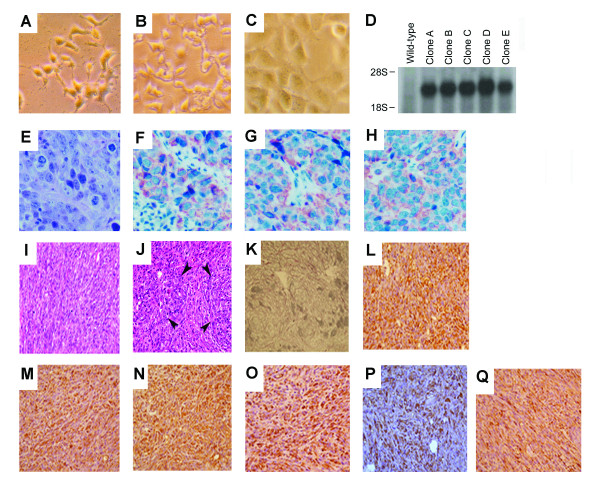Figure 1.
HCCR-1 is ivolved in tumorigenic conversion and transdifferentiation. Phase-contrast features of wild-type 293 cells (A), cells transfected vector alone (B) and HCCR-1-transfected human 293 cells (C). D. HCCR-1 mRNA expressions in HCCR-1-transfected human 293 cells (designated as clone A, B, C, D, and E, consecutively), and wild-type human 293 cells. E. Hematoxylin-eosin (H-E) staining of tumor nodules taken from the nude mice xenograft. The tumor cells show similar histological features with HCCR-1-transfected allografts. Tumor cells are arranged in nests separated by fine fibrovascular septae and have polygonal shape with oval nuclei, coarse chromatin and moderate amount of cytoplasm. Numerous mitotic figures are found. Immunohistochemical stainings of HCCR-1-transfected human 293 cells xenograft. Tumor cells show positive cytoplasmic stainings for cytokeratin 8 (F), cytokeratin 19 (G), and vimentin (H), respectively. Magnifications, E) × 300; F-H) × 250. Tumorigenic conversion and transdifferentiation of NIH/3T3 cells after transfection with HCCR-1. I and J. H-E staining of tumor nodules taken from nude mice after 3 weeks injection with HCCR-1-transfected NIH/3T3 cells. [I, tumor sections show malignant spindle cell sarcoma; J, tumor sections show poorly differentiated sarcoma with focal epithelial differentiation (arrows)]. Magnification × 400. K. Reticulin stain was performed to detect reticulin fibers. Sections from the same tumor nodule were immunohistochemically stained with mouse monoclonal antibodies (DAKO) specific for epithelial membrane antigen (L), cytokeratin 7 (M), cytokeratin 8 (N), cytokeratin 19 (O), cytokeratin 20 (P), and vimentin (Q). DAB was used as the chromogen. After immunostaining, sections were counterstained with hematoxylin. Magnification × 200.

